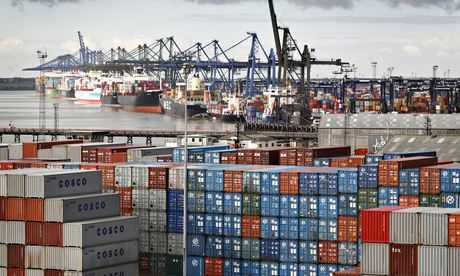
Cargo containers at Felixstowe port – Britain's huge trade deficit is bad news for the government. Photograph: David Levene for the Guardian
Britain was warned over the sustainability of the recoveryafter official figures showed the country's trading position was much worse than expected and separate data suggested consumers were running down their savings as real incomes fell.
The current account deficit – made up of the trade deficit, plus losses on overseas ventures – came in at £22.4bn in the fourth quarter last year, far above forecasts from City economists and down only slightly from a record £22.8bn deficit in the third quarter.
It was well above a consensus forecast of a £14bn deficit in a Reuters poll of economists. As a percentage of GDP, the deficit was 5.4%, down from 5.6% in the third quarter.
Separate data confirmed GDP rose 0.7% in the fourth quarter, as expected, but detail showed the percentage of household savings fell to a five-year low in 2013 while real disposable income slipped 0.1% in the last three months of the year.
The current account gap underlined fears about imbalances in the UK economy, said Philip Shaw, economist at Investec. Describing the currrent account figures as "very poor" he said: "As a proportion of GDP, the current account positions in Q3 and Q4 last year represent the largest two quarterly deficits in the history of the UK (5.6% and 5.4% respectively) and sit uncomfortably with hopes of an external rebalancing in the economy."
For 2013 as a whole, the ONS said the UK was a net borrower of £65.7bn, up from £55.4bn in 2012. "This was mainly a result of increased deficits in income and current transfers, partially offset by a decreased deficit in trade," it said, which will be of some comfort to George Osborne as he vows to raise net exports and boost Britain's trade performance.
ONS chief economist Joe Grice underlined the net trade situation in a statement alongside Friday's figures. "As a percentage of GDP, the current account deficits over recent quarters represent some of the largest on record. However, relatively little of this is due to deteriorating net trade. Most of the decline stems from falling income from UK assets overseas, compared with income from foreign-owned assets in the UK," he said.
But Rob Wood, chief UK economist at German bank Berenberg, said: "This looks like a domestic recovery and it is quacking like one. Hence the UK's colossal balance of payments deficit is showing no signs of closing … The UK is storing up big problems for the future."
Separate data confirmed economic growth of 0.7% in the fourth quarter. While unchanged from the previous two Office for National Statistics estimates, this release provided more detail on the nature of that growth.
Samuel Tombs, UK economist at the thinktank Capital Economics, said the details painted a mixed picture on rebalancing. "On a positive note, a bigger proportion of the 0.7% rise in GDP in the fourth quarter is now thought to have come from net exports. Business investment is also still thought to have grown by 2.4% quarter-on-quarter. But as we feared, the 0.4% quarterly rise in real household spending was funded by households saving less."
Providing more evidence people were having to dip into their savings after years of falling real wages, the ONS said there was a drop in households' saving ratio, which estimates the amount of money households have available to save as a percentage of their total disposable income.
Suggesting that Osborne's bid to turn things around with his "budget for savers" this month will face big challenges, the savings ratio slumped to 5.1% in 2013 from 7.3% in 2012. For the fourth quarter alone, the savings ratio dropped to 5% from 5.6% in the third quarter.The ONS also revised down its estimate for growth over the whole of 2013 to 1.7% from a previous estimate of 1.8%.
While recent growth and the outlook from many forecasters puts the UK ahead of many other advanced economies in terms of the pace of GDP expansion, comparisons with how it has regained ground since the global financial crisis are less favourable.
Britain's GDP remains 1.4% below the pre-downturn peak. While the government has pushed for a rebalancing towards more manufacturing and exports and less reliance on consumer spending, the shape of the recovery so far suggests little progress.
The ONS said on Friday that the dominant service sector had surpassed its pre-crisis peak in the autumn of last year. However, the production industries remain 12.1% below their pre-downturn peak, with manufacturing 8.9% lower. Similarly, construction remains 12.5% below the peak.
No comments:
Post a Comment
thank you for your precious time and feedback.